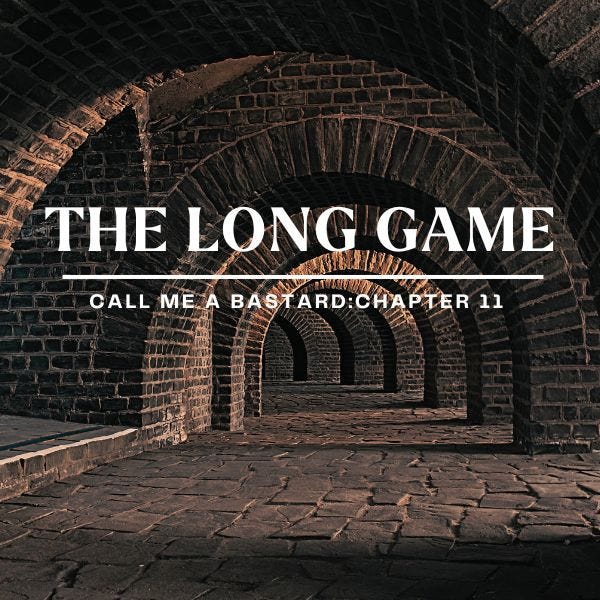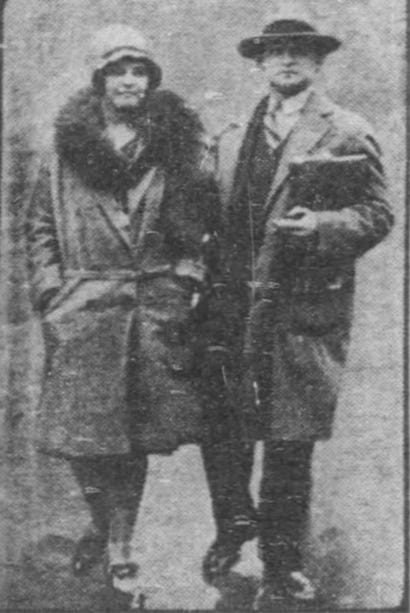Call Me A Bastard is a weekly serialized book that tells the true and scandalous story of Aimee Henry and Mary Martha Parker. New chapters are released each Tuesday beginning June 11, 2024. Subscribe today, and we’ll deliver Call Me a Bastard and a bunch of other fantastic free content to your email each week!
If you’d like additional content, or just want to support The Lost & Found Story Box, we’d love to have you as a paid subscriber. Your paid subscription helps support Call Me a Bastard and future projects, and gives you access to exclusive content like Author Q&A Sessions, Guest Features, Fan Engagement Opportunities, Virtual Wrap-up Parties, Unlimited Access to the Story Archives and more.
Read Call Me a Bastard from the beginning.
Release Date: September 3, 2024
America had changed a lot in the years since the end of WWI. Soldiers had returned home with more European and open views about sex and relationships, and American women had been given the vote, empowering them in ways big and small. Marriage as an institution had undergone fundamental changes, as well. Divorce rates skyrocketed as more and more men and women desired romance and true love instead of settling for compatibility and social convention in their marriages.
Academic spaces like those found at Columbia University led the way in many of the social changes which took place in the 1920s, and as an outspoken, confident and popular academic in an unhappy and unsatisfying marriage, it’s not hard to imagine John Morecroft choosing to seek the companionship of a much younger woman like 29-year-old Marion Traub Patterson.
It’s also not hard to imagine that Aimee Henry was fully aware of her husband’s infidelity.
Their marriage had been on the rocks for years, and, as John’s celebrity had grown, so too had his absences from the family home. Given his ego and cruel disregard for Aimee’s feelings or well-being, its likely John didn’t even try to hide the fact that he’d found someone else.
Sometime in early 1928, he approached Aimee and demanded that she sign the paperwork he needed to obtain a quick divorce in Mexico.
How John approached the topic is unknown, but it’s possible he was forthright, explaining that he’d falled in love with someone else and wanted to spend the rest of his life with her.
He may have used a carrot-and-stick approach, promising Aimee financial security with a generous alimony agreement while also threatening to prevent her from seeing their son if she didn’t comply.
Or, given his history, John may have just tried to bully Aimee into signing by exploiting her vulnerabilities, reminding her, as he’d done countless times before, that she was so unlovable that even her own mother hated her.
Whatever approach John took, hindsight suggests he seriously misread the room.
Perhaps blinded by the steam of his illicit affair, John failed to see the profound transformation his wife had undergone since her 1925 encounter with Dr. MacKendree, or recognize the deep need for reckoning which it had spawned.
Because, instead of seeing the end of her marriage as another in a long string of personal failures, I think Aimee saw it as an opportunity. More than that, the opportunity she’d been waiting for.
In April of 1928, Aimee signed the paperwork to end her 16-year marriage to John, allowing her husband to believe he’d finally gained the upper hand in their relationship.
Although the official documents have not been located, Aimee would later say the agreement stated that John would take full custody of their son and pay her $150 a month in alimony. In addition, Aimee would be granted weekly visits with John JR, but only if he agreed to them.1
With the paperwork signed, John quickly obtained a divorce in Mexico, and shortly after, he and his mistress were married.
Which might explain why John chose to file for divorce in Mexico instead of New York in the first place.
In New York, it could take three months for a divorce to be finalized in 1928, and even then, John wouldn’t have been allowed to marry again as long as Aimee was alive, or unless he petitioned the courts to modify the divorce, a process which required “three years of proof of good conduct”. 2
Mexican divorces, on the other hand, could be finalized in a matter of days, and allowed the filing party to marry as soon as they found someone to sign the next marriage license. No questions asked.
Although benefits like these made Mexican divorces wildly popular among people like John who could afford them and wanted to remarry as quickly as possible, they were also pretty controversial, and at least potentially problematic.
Not every state accepted Mexican divorces as valid, and some saw them as not only invalid, but illegal. New York, for example, viewed a Mexican divorce as an attempt to evade state law, procedure, and public policy and considered it a fraud on the court.
And, when the divorce was followed by a quick remarriage, things got even messier, as explained in a 1929 legal journal:
A Mexican divorce, valid or invalid in America, in the hands of one spouse, not only serves as a convenient pretext for remarriage, but confronts the other spouse with a fait accompli, which stands considerable chance of eventual acceptance by the latter out of sheer lassitude or because of the cost of contesting it and the impossibility of ever restoring the situation to the status quo ante.”. 3
In other words, even if a Mexican divorce was eventually deemed invalid by an American court, the cost of fighting it, and the fact that nothing could put Humpty Dumpty back together again, meant that few victims of Mexican divorces ever even tried to have them overturned.
When school got out for the summer of 1928, John JR was sent to Camp Yankee, a private summer camp located in Eastport, CT. It’s not known if the agreed upon visits between Aimee and her son had taken place during the previous months, but once John JR started camp, the visits surely did end.
John had broken his divorce agreement and given Aimee her opening.
Sometime in early July, she and her attorney, Homer F. Carey, appeared before New York County Supreme Court Justice Alfred Frankenthaler, seeking full custody of John JR on the grounds that his father had remarried and was refusing to let Aimee see her son as agreed to in an earlier-obtained Mexican divorce.
She also claimed she’d signed the paperwork for that divorce under force and duress, and therefore the divorce itself was invalid. Her husband, Professor John Morecroft of Columbia University, was therefore both a bigamist and an adulterer.
Given John’s notoriety and reputation, newspapers across New England quickly picked up the story and ran with it, and although few headlines mentioned Aimee, nearly all included John’s name, his occupation, his place of employment or all three.
“Seeks Custody of Son: wife Tells Court Professor Morecroft Refuses Permission to See Boy” 4
Aimee must have been delighted, She knew John, and she knew he would do anything to avoid a scandal that could stain his reputation or put his career in jeopardy.
On July 19, John JR was called into Justice Frankenthaler chambers to answer some questions and share his thoughts on the custody agreement. According to multiple reports, the 14-year-old refused to speak to his mother, while “[keeping] his smiles for his father”. 5
John Harold Morecroft, Jr, the 14-year-old son of a Columbia radio engineering professor, promised Supreme Court Justice Alfred Frankenthaler that he would receive his mother and be courteous should she visit him this summer at Camp Yankee, Eastport, CT.
This unusual promise was extracted from the boy in Justice Frankenthaler's chambers where a private hearing was held on the application of Mrs. Aimee Morecroft, divorced wife of the professor, for custody of their son. The decision was adjourned until September 7, after the boy's father agreed to permit visits to the boy from his mother. 6
That Justice Frankenthaler needed to secure a promise of civility from the 14-year-old speaks volumes.
That he granted Aimee unsupervised visitation with her son while he was at summer camp is telling, as well, and was likely seen by John and his legal team as an indication that the case to set aside his Mexican divorce had shifted in Aimee's favor.
In response, John amended his claim a month later, saying the divorce he’d obtained was valid, not because Aimee had signed the paperwork, but because she had committed fraud against him at the time of their marriage.
She'd known all along she was illegitimate, and she hadn't told John the truth until it was too late, until they were married and expecting a child. And even then he’d had to verify the information with her mother. 7
On September 17, Aimee made a formal and legal admission to the truth of John’s statement.
Shortly after, Justice Frankenthaler granted Aimee partial custody of John JR, ordered John to pay her $200 a month in alimony, and discontinued the case.
Then Aimee and her attorney left the judge’s chambers, walked down the hall to the Clerk of Court’s office and filed a petition to have the court legally declare Aimee the illegitimate daughter of society matron Mary Martha Parker.
Copyright 2024 Lori Olson White
I don’t know about you, but when I was originally researching this story and came across this part of Aimee’s story, I was cheering her on! What are you thoughts on Aimee’s transformation, and have you ever undergone a transformation in your own life?
The Lost & Found Story Box is reader-supported. When you buy through links on our site, we may earn an affiliate commission.
Chapter End Notes
1 “Seeks Custody of Son: Wife Tells Court professor Morecroft Refuses Permission to See Boy”, New York Times, New York, NY, July 20, 1928, P. 3.
2 Marriage and Divorce. (1925). United States: U.S. Government Printing Office, P. 16
3 From The Divorce of Americans in Mexico, Lindell T Bates, 1929 American Bar Association Journal, V 13, N 11, November 1929, pp 709-713
4 “Seeks Custody of Son: Wife Tells Court professor Morecroft Refuses Permission to See Boy”, New York Times, New York, NY, July 20, 1928, P. 3.
5 “Mrs. Morecroft Can See Her Son, Lawyers Agree’, The Republican, Springfield, MA, July 20, 1928, P. 10.
6 “Youth, 14, Promises Court to Accept Mother’s Visit”, Daily News, New York, NY, July 20, 1928, P. 16.
7 “Suit Over Boy Ends: Reach Compromise in Fight to Set Aside Divorce”, Daily News, New York, NY, September 20, 1928, P. 13.







Me: I am wondering what so public a declaration will do to her relationships with Mary Martha and other relatives? Of course her husband is the one who made it public, she and her lawyer were the ones who made it official.